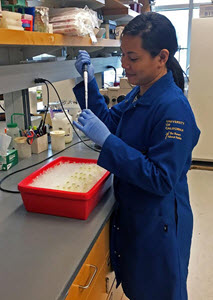
Graciel prepares zebrafish embryo samples for RNA extractions to assess gene regulation after PAH exposure. (Provided by Graciel Diamante)
Polycyclic aromatic hydrocarbons (PAHs) can disrupt important signaling pathways that transcribe genes during fish’s early embryonic development, which could cause malformations. Graciel Diamante is conducting laboratory experiments with fish embryos to understand how weathered PAHs affect fish development. She is also finding that her work demonstrates the importance of perseverance, giving back, and collaborating within a diverse scientific community.
Graciel is an environmental toxicology Ph.D. student at the University of California, Riverside (UCR) and a GoMRI Scholar with the RECOVER consortium.
Her Path
Graciel began pursuing biology as an undergraduate at California State University, Northridge (CSUN) after her enthusiastic biology professor sparked her interest in the field. She explored different research programs and worked in several labs and summer research opportunities to narrow her interests. She discovered a passion for toxicology while working on a University of California, Los Angeles summer project researching how saporin – a ribosome-inactivating protein found in soapwort plants – causes toxicity.
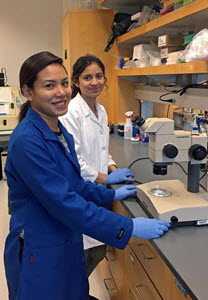
Graciel (left) and Norma Menjivar-Cervantes, an undergraduate at UCR, assess zebrafish embryos after PAH exposure. (Provided by Graciel Diamante)
She completed her undergraduate degree in cell and molecular biology and entered UCR’s environmental toxicology Ph.D. program. There, her interest in understanding how different compounds affect fish cardiovascular development led her to her advisor, Dr. Daniel Schlenk. Although Dr. Schlenk did not have an open position when Graciel arrived, he was impressed by her persistence and took her on as a graduate teaching assistant. She also conducted laboratory research while attending classes until Schlenk’s lab began its collaboration with the RECOVER consortium. “When the GoMRI grant came in, she was my first choice to put on as graduate student support,” said Schlenk.
Her Work
Chrysene is one of the most persistent PAHs in the water column following an oil spill and can produce oxygenated derivatives such as 2- and 6-hydroxychrysene after undergoing photo-oxidation. These hydroxylated compounds can disrupt important estrogen-signaling pathways during embryonic development, but little else is known about their toxicity. Graciel investigates the signaling pathways involved in hydroxylated PAH toxicity using zebrafish as a model for vertebrate development.
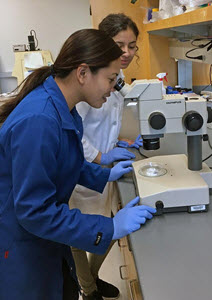
Graciel (left) and undergraduate Norma Menjivar-Cervantes use a miscroscope to assess the impacts of chemical exposure to zebrafish embryos. (Provided by Graciel Diamante)
Graciel prepares zebrafish embryos so that they are all the same developmental stage and conducts 74-hour exposure experiments using different concentrations of 2-hydroxychrysene and 6-hydroxychrysene (0.5 μM to 10 μM). Using real-time polymerase chain reaction (qPCR), she analyzes the embryos to assess the expression of certain genes that these chemicals can potentially alter and evaluate the occurrence of deformities compared to controls. She also determines the number of dead and alive embryos during the experiments.
She is observing that, unlike the parent compound chrysene, 2-hydroxychrysene and 6-hydroxychrysene exposures of at least 0.5 μM and 3 μM, respectively, increase developmental defects including cardiac, circulatory, and eye defects. The 6-hydroxychrysene concentrations of at least 3 μM decrease embryo survival, while 2-hydroxychrysene concentrations do not. Next, Graciel will conduct the same experiment using mahi mahi embryos and determine if the same effects are observed across fish species. She will use lower hydroxylated PAH concentrations and evaluate embryos for the deformities and altered transcripts found in the zebrafish experiments.
Her Learning
Graciel is an active mentor in the UCR’s Research in Science and Engineering (RISE) undergraduate program, which helps students from diverse backgrounds get involved with research. While she was an undergraduate student participating in CSUN’s Research Initiative for Scientific Enhancement program and later its Minority Access to Research Careers program, Graciel saw first-hand the impact such programs can have on a student’s professional growth. “As a mentor, I want teach them about a project’s importance, experimental design, and the ups and down of research – things you can’t learn in a classroom setting,” she said. “I want them to find what it is that inspires them, so that they can find a career they truly enjoy.”
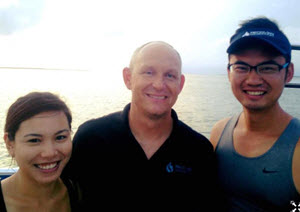
Graciel (left) with RECOVER scientists Dr. Daniel Schlenk (center) and Dr. Elvis Xu (right). (Provided by Graciel Diamante)
Graciel said that working in Schlenk’s lab during her GoMRI research taught her that science is a continual learning process. “Just as you uncover the answer to one question, another question arises.” She also learned that science pushes forward collaborations. “The importance of networking became even clearer when I joined the GoMRI community,” she said. “The RECOVER group has great scientists as well as some of the nicest people I have met.”
Living and attending school in a culturally mixed environment has helped Graciel meet and work with individuals from unique backgrounds. Cultural diversity has had an important impact on her personal maturity and shown her the importance of a diverse scientific community. She explained, “Research needs different ideas and is highly dependent on creativity and critical thinking. There is no better way to obtain this than from diverse individuals.”
Her Future
Graciel hopes to attain a post-doctoral position, continue researching fish cardiac development and physiology, and combine toxicology and developmental biology to investigate contaminants and their specific mode of action. Ultimately, she wants to become a professor and foster students’ curiosity about science and promote higher education. She suggests that students considering a science career get involved in a research project to help focus their ambitions. Gaining research experience and working in multiple labs as an undergraduate helped Graciel prepare for graduate work and her overall scientific career. “These experiences helped me figure out what my interests were and if this was the career I wanted to pursue,” she said.
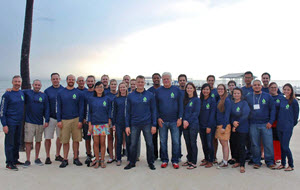
Graciel and the RECOVER team pose for a photo at a consortium All-Hands Meeting. (Photo by Daniel DiNicola)
Praise for Graciel
Schlenk said Graciel displayed a positive attitude and persevered in the face of setbacks. He explained that when the project began, it appeared that Graciel was seeing very significant effects on the fish. However, she discovered that her results were caused by a pathogen infestation in the animal model, not the chemicals she was testing. Rather than giving up, Graciel quickly began preparations to repeat the experiment. “She spent almost a whole year on her project and had to repeat everything all over again using a different animal,” he said. “So many students say ‘tell me the easy way out’ and she’s never ever asked that. It’s been neat to see her develop through this project so that she knows now what studies to do and what end points to look at. It’s very encouraging for me as a mentor.”
Schlenk explained that Graciel is a first-generation college student and that her passion for education and women in science is evident in mentoring female undergraduate students. Schlenk believes that the students’ increasing excitement about science and research is due to Graciel’s mentorship. “It’s wonderful that she’s able to touch students’ lives,” he said. “I think she’s so grateful for the opportunities she’s had that she wants to show her gratitude by doing the same things for younger students – kind of passing the torch.”
Schlenk also discussed Graciel’s personal interactions in the lab, describing her as “the mom in the group,” helping out and taking care of issues without complaint. He concluded, “She’s just a wonderful, caring person who wants to do the right thing. It’s so refreshing.”
The GoMRI community embraces bright and dedicated students like Graciel Diamante and their important contributions. The GoMRI Scholars Program recognizes graduate students whose work focuses on GoMRI-funded projects and builds community for the next generation of ocean science professionals. Visit the RECOVER website to learn more about their work.
************
The Gulf of Mexico Research Initiative (GoMRI) is a 10-year independent research program established to study the effect, and the potential associated impact, of hydrocarbon releases on the environment and public health, as well as to develop improved spill mitigation, oil detection, characterization and remediation technologies. An independent and academic 20-member Research Board makes the funding and research direction decisions to ensure the intellectual quality, effectiveness and academic independence of the GoMRI research. All research data, findings and publications will be made publicly available. The program was established through a $500 million financial commitment from BP. For more information, visit http://gulfresearchinitiative.org/.
© Copyright 2010- 2017 Gulf of Mexico Research Initiative (GoMRI) – All Rights Reserved. Redistribution is encouraged with acknowledgement to the Gulf of Mexico Research Initiative (GoMRI). Please credit images and/or videos as done in each article. Questions? Contact web-content editor Nilde “Maggie” Dannreuther, Northern Gulf Institute, Mississippi State University (maggied@ngi.msstate.edu).
